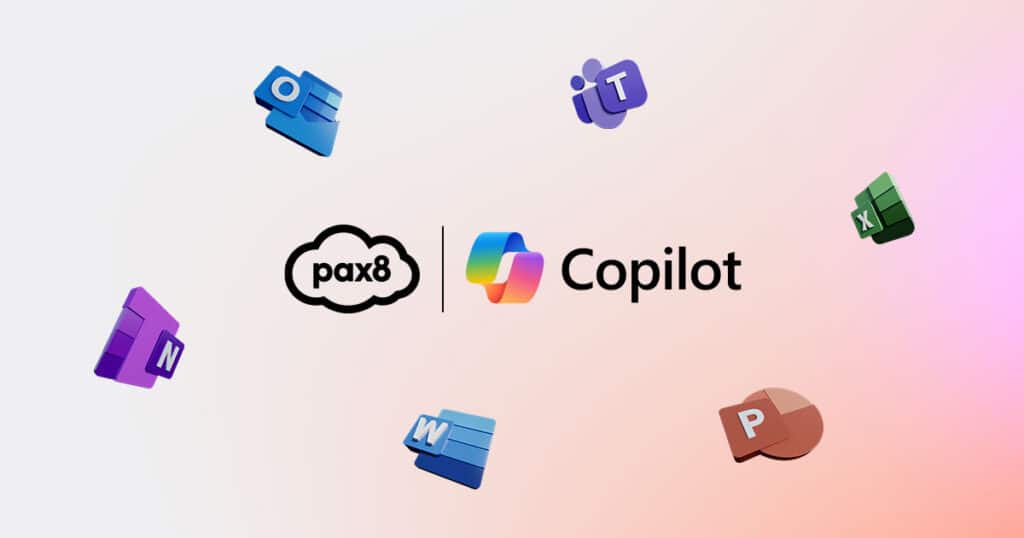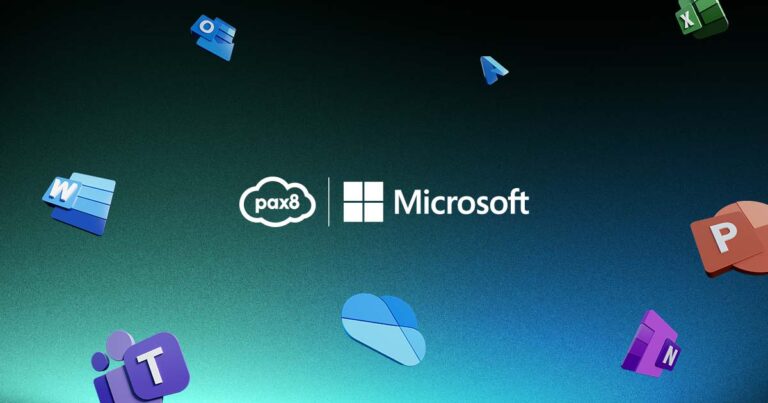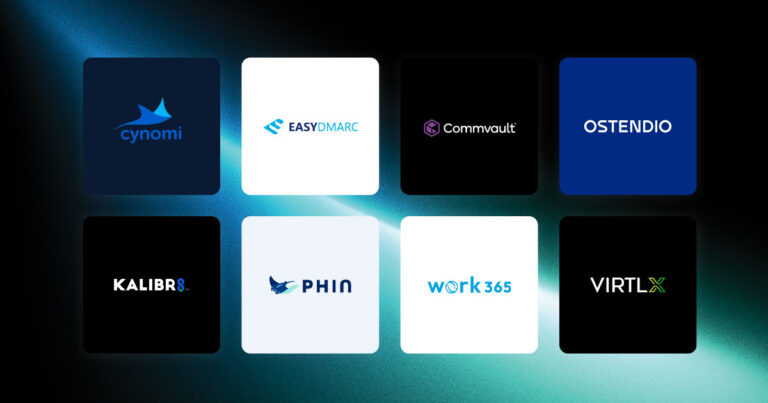This post was last updated June 10, 2024.
Artificial intelligence (AI) has already begun to usher in a new era of productivity and efficiency in the workplace. Just months after its release, Microsoft Copilot has been a game changer for not only organizations looking to elevate their capabilities but also managed service providers (MSPs), who have seen great success in helping their clients prepare for and deploy Copilot. Read on to learn the latest about the different versions of Copilot that are available and how it can make a difference in your business and the business of your customers.
What is Copilot?
Copilot is an AI-powered productivity tool designed to assist users in creating, designing, and collaborating more effectively within Microsoft 365 and other applications. It seeks to increase productivity for organizations of all sizes, including small- to medium-sized businesses (SMBs), by generating content based on user prompts within Microsoft apps.
Copilot goes beyond traditional productivity tools by offering personalized and interactive ways to access web content, applications, and organizational data. It does this by integrating organizational data with Microsoft Graph and the Microsoft 365 apps that businesses use every day, including Word, Excel, PowerPoint, Outlook, and Teams. This helps users gain relevant insights from their data and start creating faster.
Copilot is based on Microsoft’s Prometheus large language model (LLM), which was built using OpenAI’s GPT-4 LLM as a foundation. It was first launched as Bing Chat in February 2023.
Who can purchase Copilot?
Anyone with the following Microsoft SKUs can purchase Copilot:
- Office 365 E3
- Office 365 OE5
- Microsoft 365 Business Basic
- Microsoft 365 Business Standard
- Microsoft 365 Business Premium
- Microsoft 365 E1
- Microsoft 365 E3
- Microsoft 365 E5
- Microsoft 365 F1
- Microsoft 365 F3
Although Copilot is available for all these versions of Office and Microsoft 365, we do recommend M365 Business Premium at minimum to ensure that you have the appropriate security measures in place that are in line with best practices for AI. Take the quiz to see if you or your client are AI-ready.
What is available now for Copilot and what can it do for your clients?
Different versions of Copilot are available, and which version you choose depends on your or your client’s specific needs.
- Copilot for the web: A free version that allows you to ask questions via the web browser and get instant responses from Copilot’s AI. You can also access Copilot’s features from the search bar of Bing.com by typing “@Copilot” before your query. You can also open Copilot in your web browser by heading to copilot.microsoft.com. Copilot for the web is ideal for casual users who want to explore what Copilot can do or need quick answers to simple questions.
- Copilot for Microsoft 365: A premium version that integrates with Microsoft 365 apps such as Word, Excel, Outlook, PowerPoint, and Teams. You can use Copilot’s natural language interface to perform tasks within these apps, such as creating documents, charts, slides, emails, and messages. You can also use Copilot’s voice assistant to dictate commands or queries using your microphone. Copilot for Microsoft 365 is perfect for professionals who want to save time and enhance their productivity with Copilot’s AI assistance.
- Copilot Studio: Build your own Copilots, available across multiple channels, to serve employees and customers. Copilot Studio offers a graphical development environment to build copilots using generative AI, sophisticated dialog creation, knowledge, actions, and built-in analytics that work with Microsoft conversational AI tools.
Learn more about the complete list of features and products.
How does Copilot work in Microsoft 365?
There are many applications of what Copilot can do within Microsoft 365 apps. Here are a few examples:
- Word: Draft a proposal based on provided data from other documents, such as from Word, Excel, or PDFs.
- Excel: Simplify sales data by type and channel, then create a table from them.
- PowerPoint: Create a new presentation based on provided documents, including stock photos.
- Outlook: Summarize emails missed during time off, draft response emails, and sharpen tone of email copy.
- Teams: Get up to speed on conversations by quickly reviewing the main points, action items, and decisions without having to scroll through long threads.
Continue to be inspired by visiting the Copilot lab.
In addition, users can activate Copilot for Web to enable myriad benefits:
- Summarized search: Users can quickly conduct research and receive a summary of any topic by using advanced web search, image search, and news search capabilities.
- Search by images: Upload an image and Copilot can process it to aid in its output.
- AI-powered art: Quickly create graphic artwork from prompts with Dall-E’s AI art capabilities.
- Suggested follow-ups: Copilot will suggest follow-up questions to your prompt, helping guide your web journey.
Can I use Copilot within my MSP business?
Copilot isn’t just for your clients; it has many benefits that you can use directly in your business. Here are some key features available now that can help you optimize your MSP:
- Research and learning: MSPs can harness Copilot’s advanced web search, image search, and news search capabilities to effectively research and learn about topics, ensuring they stay ahead in the ever-changing tech landscape.
- Graphic artwork creation: The integration of Dall-E’s AI art capabilities allows MSPs to create and present graphic artworks that align seamlessly with their prompts, enhancing the visual aspects of their presentations and communications.
- Specialized Copilot experiences: Microsoft extends Copilot experiences to various tools like Dynamics 365, Power Platform, Security Copilot, and Copilot Studio, tailoring AI-powered assistance to specific business functions, security needs, and customization requirements.
See how to get your creative juices flowing with what’s possible with Copilot.
How to get started with Copilot
To get started with Copilot, it’s important to get the organization AI-ready. To prepare, start by migrating data to Azure and working with Microsoft 365 to build the foundation for the organization’s AI future.
Currently, Microsoft 365 users can use their Entra ID to connect to Copilot on the web. Once signed in, users can begin chatting and generating content. Here are some solutions MSPs can implement to get clients ready:
- Implement Microsoft 365: Ahead of Microsoft 365 Copilot being released to Cloud Service Providers (CSPs), it’s imperative that interested clients learn how Microsoft 365 brings together identity, apps, organizational data, and security to become AI-ready. Although Copilot is available for M365 Business Basic and Standard, Pax8 recommends that you start activating Microsoft 365 Business Premium, E3, or E5 for your clients today to ensure the correct levels of security. Read more.
- Security: Begin adopting Microsoft security solutions such as Defender, Purview, and Lighthouse. Read more.
- Dynamics: Start using Dynamics 365 today; if you’re already a Dynamics user, activate the preview to learn how Copilot can impact your current CRM and ERP processes.
- GitHub: To use GitHub Copilot, you need to have a GitHub account and a Visual Studio Code editor. Then you can sign up for the Copilot technical preview and follow the instructions to install the Copilot extension. Once you have Copilot installed, you can start using it in any file that has a supported language mode. You can also use Copilot in GitHub Codespaces, which are cloud-based development environments that you can access from any browser.
Tips on how to use prompting in Copilot effectively
Prompting is the key to maximizing the benefits of Microsoft Copilot. MSPs can follow these tips for effective implementation and client success:
- Write clear and descriptive comments or docstrings for your functions and classes. Copilot will use them to generate relevant code suggestions and documentation.
- Use meaningful variable names and follow the coding conventions of your language and framework. Copilot will learn from your style and preferences and adapt to them.
- Suggestions should be reviewed, chosen, and edited to best align with needs. While Copilot is a powerful tool, it’s not a replacement for human judgment and creativity.
- Provide feedback to Copilot to help it perform better. By accepting or rejecting suggestions, Copilot will learn preferences and improve over time.
- Explore different modes and settings offered by Copilot to customize the experience. You can also adjust the confidence level, the number of suggestions, and the keyboard shortcuts of Copilot to suit your preferences.
- Encourage your clients to migrate data to Azure to improve performance, security, and computing cost when utilizing Copilot. Pax8 can assist with any migration projects you may have — learn more about Pax8 Professional Services.
Check out the prompting tips in Academy.
Other Copilot tips
Microsoft Copilot is not just a tool; it’s a transformative force that can reshape how MSPs operate and deliver value to clients. It takes time for individuals and organizations to learn how to fully take advantage of it, so increasing user adoption is a key component to Copilot’s success within your organization or that of your clients.
Training is key, so start small with a pilot project. Not everyone will need a Copilot license as of day one; think about which groups can get the most out of the product and who are most likely to adopt this new way of working. Is Copilot worth it? Start by calculating the ROI.
By staying informed about current features and upcoming releases and implementing effective strategies, MSPs can harness Copilot’s full potential, paving the way for a more productive and innovative future of AI-powered productivity tools. Check out how some partners are looking at how Copilot will shape their business.





